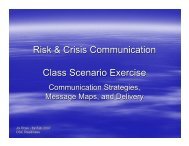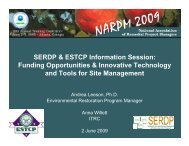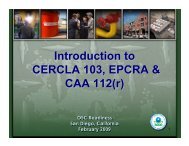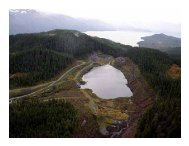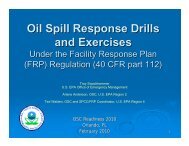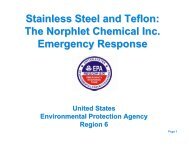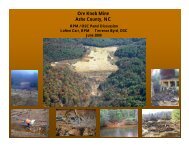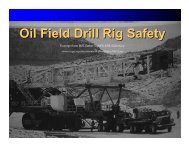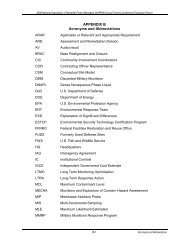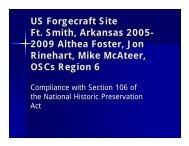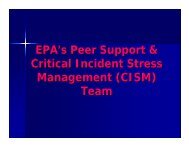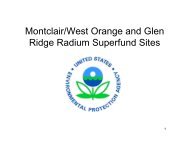OSC 2007 Evaluation Report
OSC 2007 Evaluation Report
OSC 2007 Evaluation Report
You also want an ePaper? Increase the reach of your titles
YUMPU automatically turns print PDFs into web optimized ePapers that Google loves.
<strong>2007</strong> <strong>OSC</strong> Readiness Training Program <strong>Evaluation</strong> <strong>Report</strong><br />
Alternative Countermeasures for Oil Spills<br />
Instructors: Tom Condon, EPA Region 1<br />
Nick Nichols, EPA Office of Emergency Management (OEM)<br />
William Robberson, EPA Region 9<br />
Albert Venosa, EPA Office of Research and Development (ORD)<br />
This course focused on alternative (non-mechanical) oil spill response methods that have gained<br />
popularity and acceptance among industry, federal responders and trustees, state agencies, members of<br />
Congress, and the entire oil spill response community. <strong>OSC</strong>s play a vital role in planning and using<br />
alternative countermeasures (ACMs) through participation in Regional Response Teams (RRT) and as<br />
responders to inland spills. RRT representatives may be called on more often to concur with ISB,<br />
chemical, and biological countermeasures for marine and inland spills. The use of these methods, such as<br />
ISB, dispersants, surface washing agents, chemical sorbents, and other technologies, has sparked<br />
controversy and confusion in all of EPA’s regional offices and areas. Research about these tools has<br />
helped resolve issues about toxicity, efficacy, and proper use of these tools, but conflicts and questions<br />
about their use still exist.<br />
RRTs have been tasked with designating pre-approved or expedited ACM application zones for ISB and<br />
dispersants. Other federal agencies, industry representatives, and product manufacturers continue to<br />
expand the application of dispersant use. RRTs are re-evaluating their regions’ pre-approval areas along<br />
with these efforts.<br />
<strong>OSC</strong>s, area planners, and RRT representatives were presented case studies and provided updates on the<br />
efforts of RRTs to expand the knowledge of <strong>OSC</strong>s beyond what is on the National Oil and Hazardous<br />
Substances Pollution Contingency Plan Product Schedule. Efforts are under way to document how to use<br />
the products more appropriately. Participants were updated on ongoing research by EPA’s ORD to<br />
support NCP Subpart J rulemaking efforts, including the new wave tank for dispersant testing.<br />
Bioremediation success at oil spill sites in EPA Region 3 was profiled, the use of surface washing agents<br />
in EPA Regions 1 and 5 was reviewed, and some dispersants were discussed. Instructors also provided an<br />
update on the ACM research EPA has conducted and EPA’s plans for the future. All participants were<br />
encouraged to discuss their use of ACMs and lessons learned.<br />
This course was recommended for new <strong>OSC</strong>s and RSC staff.<br />
Number of Participants Who<br />
Pre-registered<br />
Participation and Average Grade<br />
Number of Participants Who<br />
Signed Course Roster<br />
Number of <strong>Evaluation</strong><br />
Forms Submitted<br />
Average<br />
Grade<br />
54 52 29 4*<br />
* The grade displayed is the average of the grades provided on the evaluation forms, where<br />
1 = Poor, 2 = Fair, 3 = Good, 4 = Very Good, and 5 = Excellent.<br />
C-13 Comments about Individual Training Courses



